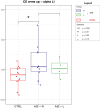Brain oscillatory activity in adolescent idiopathic scoliosis
- PMID: 36241666
- PMCID: PMC9568615
- DOI: 10.1038/s41598-022-19449-1
Brain oscillatory activity in adolescent idiopathic scoliosis
Abstract
Pathophysiology of Adolescent Idiopathic Scoliosis (AIS) is not yet completely understood. This exploratory study aims to investigate two aspects neglected in clinical practice: a defective postural central nervous system control in AIS, and alterations of body schema due to scoliosis spinal deformities. We recorded EEG data and balance data in four different standing positions in 14 adolescents with AIS and in 14 controls. A re-adaptation of the Image Marking Procedure (IMP) assessed body schema alterations on the horizontal (Body Perception Indices (BPIs)) and vertical direction (interacromial and bisiliac axes inclinations). Our results revealed no differences in balance control between groups; higher EEG alpha relative power over sensorimotor areas ipsilateral to the side of the curve and a significant increase of theta relative power localized over the central areas in adolescents with AIS. The difference in BPI shoulder and BPI waist significantly differed between the two groups. The inclinations of the perceived interacromial axes in adolescents with AIS was opposite to the real inclination. Increased theta activity and alpha lateralization observed may be a compensatory strategy to overcome sensorimotor dysfunction mirrored by altered body schema. Scoliosis onset might be preceded by sensorimotor control impairments that last during curve progression.
© 2022. The Author(s).
Conflict of interest statement
The authors declare no competing interests.
Figures





References
-
- Negrini S, Donzelli S, Aulisa AG, Czaprowski D, Schreiber S, de Mauroy JC, Diers H, Grivas TB, Knott P, Kotwicki T, et al. 2016 sosort guidelines: Orthopaedic and rehabilitation treatment of idiopathic scoliosis during growth. Scoliosis Spinal Disord. 2018;13(1):1–48. doi: 10.1186/s13013-017-0145-8. - DOI - PMC - PubMed
Publication types
MeSH terms
LinkOut - more resources
Full Text Sources
Medical

